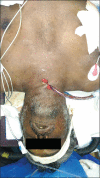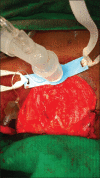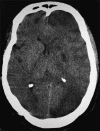Blunt Trauma Neck with Complete Tracheal Transection - A Diagnostic and Therapeutic Challenge to the Trauma Team
- PMID: 28701849
- PMCID: PMC5492745
- DOI: 10.4103/ijccm.IJCCM_103_17
Blunt Trauma Neck with Complete Tracheal Transection - A Diagnostic and Therapeutic Challenge to the Trauma Team
Abstract
Survival following trachea-esophageal transection is uncommon. Establishing a secure airway has the highest priority in trauma management. Airway management is a unique and a defining element to the specialty of emergency medicine. There is no doubt regarding the significance of establishing a patent airway in the critically ill patient in the emergency department. Cannot intubate and cannot ventilate situation is a nightmare to all emergency physicians. The most important take-home message from this case report is that every Emergency physician should have the ability to predict "difficult airway" and recognize "failed airway" very early and be skilled in performing rescue techniques when routine oral-tracheal intubation fails. Any delay at any step in the "failed airway" management algorithm may not save the critically ill dying patient. Here, we report a case of blunt trauma following high-velocity road traffic accident, presenting in the peri-arrest state, in whom we noticed "failed airway" which turned out to be due to complete tracheal transection. In our patient, although we had secured the airway immediately, he had already sustained hypoxic brain damage. This scenario emphasizes the importance of prehospital care in developing countries.
Keywords: Cannot intubate cannot ventilate; complete tracheal transection; surgical airway.
Conflict of interest statement
There are no conflicts of interest.
Figures






References
-
- Dertsiz L, Arici G, Arslan G, Demircan A. Acute tracheobronchial injuries: Early and late term outcomes. Ulus Travma Acil Cerrahi Derg. 2007;13:128–34. - PubMed
-
- Wong EH, Knight S. Tracheobronchial injuries from blunt trauma. ANZ J Surg. 2006;76:414–5. - PubMed
-
- Kiser AC, O'Brien SM, Detterbeck FC. Blunt tracheobronchial injuries: Treatment and outcomes. Ann Thorac Surg. 2001;71:2059–65. - PubMed
Publication types
LinkOut - more resources
Full Text Sources
Other Literature Sources
